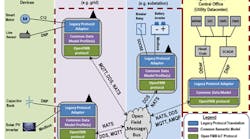The Grid Modernization Laboratory Consortium (GMLC) Resilient Distribution System (RDS) project titled Increasing Distribution System Resiliency using Flexible DER and Microgrid Assets Enabled by OpenFMB recently reached a major milestone. The work initially focused on laboratory-based co-simulation and the development of controls for use cases. Now, the project is transitioning its focus towards testing utility operational concepts in an emulated environment, in preparation for field validation. The project team will aim to demonstrate how a utility operational power system can safely operate using a control system integrated with the Open Field Message Bus (OpenFMB) architecture to increase system flexibility and resiliency.The GMLC was established as a strategic partnership between DOE and the national laboratories to bring together leading experts, technologies and resources with the goal of modernizing the nation’s grid. The GMLC project focuses on developing a framework for interoperability of field devices in both distributed and centralized control architectures. Through the OpenFMB framework, utilities can achieve true integration of informational and operational technology by enabling real-time distributed intelligence with increased operational decision making and analytics at the grid edge.The OpenFMB architecture aims to use existing industry standards and technologies to securely and efficiently federate data at the grid edge. Ultimately, the GMLC RDS project intends to accelerate the deployment of resilient and secure distribution concepts through the flexible operation of traditional assets, distributed energy resources (DERs) and microgrids. Furthermore, it will show that non-utility DERs do not interfere with the deployment of utility self-healing technologies and, in fact, can be an operational resource.
The GMLC RDS Project Then and Now
In year 1 of the RDS project, the team developed a concept of operations (CONOPS) document to capture the applicable use cases. These use cases considered a self-healing grid, utilizing a microgrid and non-utility DER assets on a feeder model based on the Duke Energy distribution network. The team developed multiple sets of use-cases, “blue-sky” days during normal conditions, and “grey-sky” and “dark-sky” days for when increasing numbers of abnormal conditions and faults occur. Different scenarios within each use-case exemplify the engagement of three different technologies:- A centralized self-healing system
- An inverter-based microgrid
- A transactive energy scheme (simulation only)
In the use cases, utility-owned assets are controlled using a layered OpenFMB-based control system that employs a circuit segment-based approach to enable flexible operating strategies. Non-utility assets are engaged using VOLTTRON agents and can include DERs and end-use loads. VOLTTRON is an open-source IoT platform developed by PNNL specifically for behind-the-meter control. Its small software system runs specially crafted agents that communicate with one another and the outside world using tagged messages in a pub-sub (publish-subscribe) model.
Most recently, the project has focused on developing, simulating and validating the architecture, controls and set points needed before equipment is deployed in the field. Building on the generalized architecture, the team modeled a specific control system to coordinate the operational use cases, including transactive control elements and then performed simulations of the CONOPS scenarios.
Furthermore, the team conducted controller hardware in the loop (CHIL) testing to ensure proper operation of both centralized and decentralized systems. This bridged the gap between simulation and field deployment by allowing for interoperability testing of hardware components in the lab. In parallel with this testing, the team conducted integrated co-simulation to ensure that the planning process can/will replicate the deployment of the developed control system. A test distribution management system is already being used to develop operational procedures for the new control strategies.
Deploying OpenFMB in the Field
The project is now entering its final phase of the operational system and control strategies to validate its performance. The high-level circuit diagram below illustrates the feeders and corresponding electrical components that are the focus of the field demonstration.
The project team is in the process of developing an integrated assessment plan (IAP) that outlines the planned field demonstration testing. The plan also defines the data that needs to be collected to validate the original research proposal made to the DOE as part of receiving grant approval. While the OpenFMB framework in combination with various control architectures could address a wide range of technology combinations, the field demonstration will focus on a specific example of fault location isolation and service restoration (FLISR), solar photovoltaic (PV) and microgrids.
While system resilience is the ultimate goal of the GMLC RDS project, the utility industry has not yet coalesced around specific metrics for resiliency. Often, IEEE-1366 metrics for reliability are used as a proxy for resiliency. For the RDS project, the key indicator of resilience will be how long the critical end-use loads can be served. The field demonstration will exhibit this resiliency through increased operational flexibility, as measured by the following:
- Autonomy: Each segment on a distribution system will have the ability to support a level of autonomous operations, coordinated with the DMS
- Coordinated Control: DERs will be able to make local high-speed decisions that will support the centralized systems that have access to a wider range of information
- Distributed DER Intelligence: DERs will be engaged as active elements to support the segment-based operation of the system
- Dynamic Network Configuration: The system is able to recognize, validate, and evaluate the specifications of new devices as well as compensate for those that cease to operate or communicate
By showing that distributed intelligence can provide reliable operations across all types of devices — regardless of communication protocols — the project aspires to enable the proliferation of edge capabilities on the distribution network while increasing its resiliency. The success of the field deployment and validation of resilience increases will drive adoption of OpenFMB on other circuits at Duke and contribute to other utilities embracing the OpenFMB framework in their operational control architectures.
OpenFMB concepts have been incorporated into a follow-on GMLC project. The Citadels project will enable networked microgrids leveraging an OpenFMB architecture. With this architecture, the networked microgrids can support normal grid-connected operations, the bulk electric system during abnormal conditions, critical end-use loads during a loss of the bulk system and bulk system restoration with self-assembling elements. In these roles, networked microgrids act as the last line of defense to safeguard the bulk system, support critical end-use loads and serve as hardened points from which the bulk system can be restored after an extreme event.
The following utilities are partnering with PNNL on the Citadels project: Electric Power Board of Chattanooga, ComEd, Avista Utilities, Duke Energy, City of Riverside Public Utilities, Entergy and Southern Company.
OpenFMB Users Group Contributions
The OpenFMB UCA International Users Group (UCAIug) has conducted its work in parallel with the GMLC project. Additionally, the North American Energy Standards Board (NAESB) successfully ratified the OpenFMB RMQ.26 standard, which was updated in January 2020 to incorporate enhancements in cyber security, publish/subscribe protocols and interoperability best practices. Contact [email protected] to obtain the latest revision of the OpenFMB standard.
The UCA OpenFMB users group also has an active Use Case Subcommittee and Testing Subcommittee which contribute and govern open source artifacts. Some of these artifacts include a DER Circuit Segment Management Use Case, Gateway Test Procedure, and Publish-Subscribe Cyber Validation Test Procedure, which are all being incorporated into the GMLC project’s field validation plans. In addition to continuing efforts to support OpenFMB adoption in the utility industry, the UCAIug OpenFMB users group has plans to establish an OpenFMB testing and certification program. This program aims to qualify the first commercial OpenFMB accredited test lab and to begin certification of early adopter OpenFMB compliant products.
Final Steps to Field Validation
While the IAP is being finalized, Duke is moving forward with procurement and deployment of devices such as automated reclosers and relays on impacted circuits. Duke is also planning to include a 5-MW/5-MWh battery as part of the Anderson Civic Center microgrid. This battery will be capable of providing grid services during normal conditions as well as back-up power to the Anderson Civic Center when in island mode because of emergency events. Once an interconnection agreement for the microgrid is in place, Duke can move forward with the remaining equipment installation.
The project team expects to finalize and approve the IAP in Q1 2021. Field validation testing can then begin and would be completed shortly after. All project results including findings from the field validation will then be compiled and reported to DOE by September 30, 2021.




